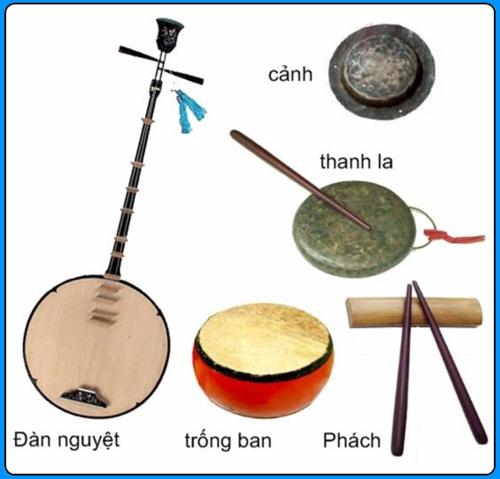Chau van is a kind of spiritual singing accompanying the hau dong (mediumship) ritual of the Mother Goddesses religion. It’s popular throughout the country, but Nam Dinh Province is considered its birthplace.
According to statistics from the Ministry of Culture, Nam Dinh Province owns 287 vestiges relating to the Mother Goddesses religion, with 470 people participating in the rituals: 246 mediums, 245 cung van (chau van singers) and 162 musical instrumentalists.
The folk performance art was created during the Tran dynasty (1225-1400) and became popular at festivals and rituals. It was performed at temples and pagodas as people believed that it was a useful way to connect to the Mother Goddesses and other gods.
Chau van (or frequently called trau van) is a religious form of art which combines singing and dancing and used for extolling the merits of beneficent deities or national heroes. Its music and poetry are mingled with a variety of rhythms, pauses, tempos, stresses and pitches.
Listening to chau van singing, you may confuse between the two following types:
Hat tho (worship singing) includes the slow chanting which is accompanied by an act of worship. Variations in the music don’t frequently happen and contain little contrast between pitch and stress.
Hat len dong is the cantillation and dancing of psychic to express the will and orders of some supernatural beings. It may contain many variations depending on the number of verses and often coming to a top or bottom of the meditation.
The instrumental music in Chau van plays a very important role either in emphasizing important passages or creating contrastive effects. Normally, the main instruments that you see in one chau van performance are moon-shaped lute (dan nguyet), accompanied by a rhythm from the striking of a piece of wood or bamboo (phach), clappers (xeng), drum (trong) and gong (chieng). Sometimes, the 16-stringed zither (dan tranh), flute (sao), eight-sound band (dan bat am) are also used in the recitation of certain poetry.
The dress worn by Chau van singers is based on the cult of the “four palaces” – a red robe symbolizing for the “heavenly palace”, a yellow robe – the “underground palace”, a green robe – the “musical palace” and a white robe – the “aquatic palace”. The headgear and the style of the robe are closely related to the supernatural being honored in the act of worship. Over time, this style of costume may vary but rule about the colors has remained unchanged.
The breathing of a Chau van singer comes from his or her midriff to nasal cavity which works as a resonance box to create an appropriate effect for religious subjects, particularly, in an atmosphere of incense and candles. Yet, the chanting must be clear enough so that all listeners are able to understand!
The lyrics in Chau Van singing were strongly emphasized. The psychic not only has a good voice and knows how to play musical instruments but he also knows how to give compliments at the right time and in the proper situation.
The art of chau van singing originated in the Red River Delta and dated back to the 16th century, later spread to the whole country. It has also adopted the essential beauty of folk songs from the uplands and highlands of the North, Center and South.
In the North, a ceremony always begins the invitation to deities to come. The master of the ceremony reads a petition and says some incantations to the underworld. After sending the invitation to the spirits, a person – frequently a woman – who sat on a mat in front of the altar, will become the speaker for the spirits.
However, one significant aspect of chau van singing in Central Vietnam is the mass participants, sometimes five persons in the same ceremony. Chau van singing in Central Vietnam is generally more prosperous than in the North. The rhythm, furthermore, is far more complicated.
If you desire to see how Chau Van singing is prepared, please come to the festival which is annually organized in the Hon Chen Palace near Hue. Due to the location on the bank of Huong River and the outsize number of participants, the celebration is held on the boats. The river is crowded with thousands of boats and people dressed in colorful clothes, dancing to the offering music in an atmosphere which is full of incense and scent of offering fruits and flowers. Chau van singing, also called hat bong in the South, follows the same pattern of chau van singing in the North and Center. Yet, some of the tunes are influenced by the classical music of the South.
Chau van singing has acquired over centuries both quintessence and folksy characteristics and proven to be a strong attraction to musicologists at home and abroad! Listening to chau van singing means further touching to one unique feature of Vietnamese culture!
Chau Van singing has been submitted to UNESCO to be recognised as the Intangible Cultural Heritage of the Humanity.


